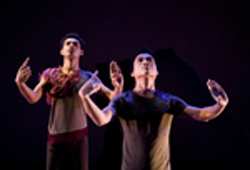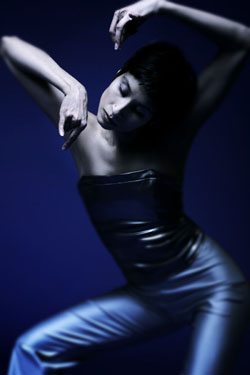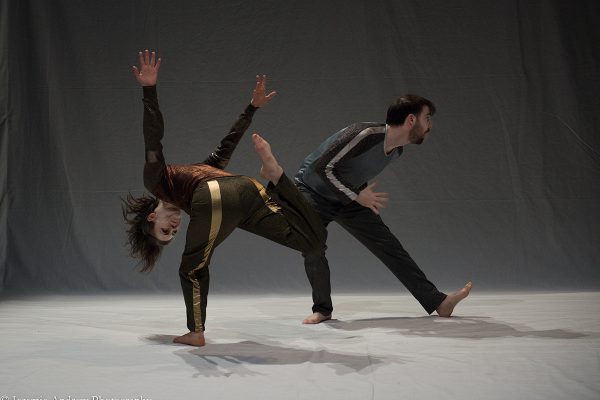It was with a heightened sense of occasion that a small opening night audience gathered at the Winch to share in the choreographic riches of the third edition of Dai Don Den. The recent and ongoing disasters in Japan were on everyone’s mind, none more so than the Japanese-Canadian members of the six-year-old Green Tea collective. With a few heartfelt words and a moment of silence, Naoko Murakoshi and company acknowledged their profound connections with the homeland and the show began. But that sense of connectedness lingered in the air long after the final bow and fade to black, a reverberation of longing, sorrow and hope.
The evening began in a ritualistic manner with Ayako Matsuura’s “Ha Ru”. Framed by three narrow ceiling-to-floor banners with shimmering patterns and dramatic lighting by Simon Rossiter (who superbly lit all of the works on the program) Matsuura poses in traditionally styled white robes with red accents. After wielding a tuning fork hidden within her extraordinary sleeves, Matsuura begins to intone a poem or song — the work by Li Bai describing spring and desolation as printed in the program — in Japanese. Like the ensuing movement, her words feel formal and severely paced. She adopts a series of angular poses moving mostly her arms, using her sleeves like flags. A final image includes pale pink petals falling gently down as the lights slowly fade. “Ha Ru” was an exercise in controlled imagery and movement — sad in its affect, dignified, and a most suitable introduction to the program.
“Nothing-Weight-Light” was a mysterious but nonetheless extremely moving dance choreographed and performed on this night by former Toronto Dance Theatre member Naoko Murakoshi (Juli Nishioka on two others). Her set invokes a fairy tale – three throne-like chairs upholstered in red velvet and set in a circle facing inward, an egg-shaped lamp hung dead centre and suspended high over a red apple on the floor. Murakoshi, clad in a white slip, dances a Graham-esque vocabulary of reaching and spinning, now and then stopping and seeming to converse or commune with ghostly presences. At times there seems to be something in her hands — she talks to it, offers it, crooning with small vocalizations. In a section when the music has faded to silence, you suddenly realize it’s the audience she has in the palm of her hand. They are mesmerized by this tiny perfect performer. She acknowledges those watching, once, with a long stare then resumes her strange dance, lying on her back and tapping her fingernails against the floor. In the closing moments of the piece, she reaches for the apple from a supine position as the lights go down. I found it all amazing — both for the quality of the dancing and for the undercurrents of narrative, which never quite break the surface.
Also mysterious and exhilarating was Peter Chin’s trio for Masumi Sato, Keiko Ninomiya and Hiroshi Miyamoto, called “a Gain”. To Sarah Peebles’ “composed soundscapes of urban Japan”, the three adapted Chin’s vocabulary of exaggerated facial expressions, mugging and shaking, mostly in isolation from each other but not always. At times it felt like a response to the sensual assault that can be urban living. At other times, Chinese opera or a slapstick heist movie. Who knows, finally, what they were doing but they were certainly doing it with great energy. Eventually, long rectangles of light appeared on the floor and the sound and movement slowed down, as if these characters had entered a dream state. They commenced murmuring — currents of an elusive narrative; I thought they were beginning to resemble characters in an Ozu film. As the music segued from temple bells and abrupt shouts to a louder, more electronic buzz, one of the characters seemed to curl up and die, her body rigidly bent in on itself. Like the rest of the works on this program, “a Gain” was blessed with a memorable closing image. Here, the two standing performers carry and place their rigoured companion in a circle of light in the centre of the stage. They turn and walk off in opposite directions. And as the lights dim, the frozen one begins to move, slowly crawling, rigidly, into the wings.
For me, the highlight of this excellent program was “a seed”, choreographed and performed by Hiroshi Miyamoto, who works frequently with Hari Krishnan and inDANCE. His dance, according to the program notes, was inspired by the classical bharatanatyam piece entitled “Alarippu” (“flowering bud”) and this was very apparent from the opening moments of the solo. Although performed initially to a Japanese vocal soundtrack (this later becomes more electronic with music selections edited by Claudia Wittman), the detailed movements of the hands — index finger to thumb — and the occasional exaggerated facial expression reveal the Indian origins of the movement. It’s a fascinating juxtaposition and Miyamoto embodies it fully with tremendous clarity and presence. His palms tell the story even when the movement opens up and becomes more expansive. A vocabulary emerges — hands cradling the face, fists, hands on heart, fingers pointing and snipping and, finally, palms across chest, open and facing up. One is left with a sense of perseverance and strength in this beautifully realized journey and fusion.
Keiko Kitano’s “Apoptosis” was also ambitious conceptually but quite striking in its bleak discussion of the Japanese suicide tradition. It starts with a chair, Kitano standing on it and gazing up into the light as if facing something huge. To discordant violin music by Rick Thomson, Kitano moves to and from the void, attracted and repelled. A very large man in a dark suit (Daniel Schnee) enters, lifts Kitano up and places her centre stage then sits himself down in the chair to watch. As she circles backwards, he blows into a soprano saxophone, whispers to her through cupped hands and rhythmically slaps his thighs. Is he a puppet-master to her puppet? Devil to her human being on the edge? Black and white projections (by Don Sinclair) play against the huge back wall — in a stepping effect, echoing Kitano’s moving body. Schnee then stands behind Kitano in a more traditional configuration as she kneels frowning. He plays on a Japanese flute. As fireworks explode on the screen behind them, Kitano rises in time with the booms and Schnee wields the flute as if it were a sword poised to fall. The term “apoptosis” refers to programmed cell death and its process of “suicide”. This work grimly ponders what is a natural biological activity and applies it to the individual and social configurations of Japanese culture.
The final two works on the program felt a bit anticlimactic to me, especially Keiko Ninomiya’s “satu dua tiga”. Though interesting conceptually — the use of a traditional Balinese dance to construct a portrait of a harried Japanese businesswoman — the work failed to gel, to the point where it felt like a gimmick and not much more. After much frantic theatrical business mimicking the rush rush quality of an urban working day, punctuated with brief phrases in the traditional style of undulating hands and exaggerated eye movements, the piece calms down in a spotlit corner around a low table and pillow, a kettle boiling away. I enjoyed these final images of Ninomiya quietly taking tea, in sympathy perhaps; a little rest after a forced movement experiment that didn’t really work.
In spite of what must have been the most anxious of circumstances, the green tea collective’s third Dai Don Den was beautifully presented and full of ideas, imaginatively expressed. It was a generous program in all respects and did what dance can still do best: send you out into a cold night with a warm heart and a head full of striking images. The situation in Japan has proved daunting and profoundly frightening, but on this night we were reminded once again that strength can be found in beauty.
Tagged: Asian, Contemporary, Performance, ON , Toronto





